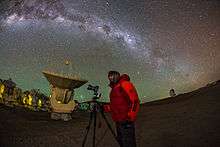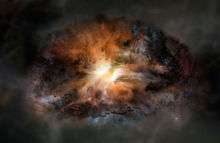Infrared astronomy
.jpg)
Infrared astronomy is the branch of astronomy and astrophysics that studies astronomical objects visible in infrared (IR) radiation. The wavelength of infrared light ranges from 0.75 to 300 micrometers. Infrared falls in between visible radiation, which ranges from 380 to 750 nanometers, and submillimeter waves.
Infrared astronomy began in the 1830s, a few decades after the discovery of infrared light by William Herschel in 1800. Early progress was limited, and it was not until the early 20th century that conclusive detections of astronomical objects other than the Sun and Moon were detected in infrared light. After a number of discoveries were made in the 1950s and 1960s in radio astronomy, astronomers realized the information available outside of the visible wavelength range, and modern infrared astronomy was established.
Infrared and optical astronomy are often practiced using the same telescopes, as the same mirrors or lenses are usually effective over a wavelength range that includes both visible and infrared light. Both fields also use solid state detectors, though the specific type of solid state detectors used are different. Infrared light is absorbed at many wavelengths by water vapor in the Earth's atmosphere, so most infrared telescopes are at high elevations in dry places, above as much of the atmosphere as possible. There are also infrared observatories in space, including the Spitzer Space Telescope and the Herschel Space Observatory.
History


The discovery of infrared radiation is attributed to William Herschel, who performed an experiment where he placed a thermometer in sunlight of different colors after it passed through a prism. He noticed that the temperature increase induced by sunlight was highest outside the visible spectrum, just beyond the red color. That the temperature increase was highest at infrared wavelengths was due to the spectral index of the prism rather than properties of the Sun, but the fact that there was any temperature increase at all prompted Herschel to deduce that there was invisible radiation from the Sun. He dubbed this radiation "calorific rays", and went on to show that it could be reflected, transmitted, and absorbed just like visible light.[1]

Efforts were made starting in the 1830s and continuing through the 19th century to detect infrared radiation from other astronomical sources. Radiation from the Moon was first detected in 1873 by William Parsons, 3rd Earl of Rosse. Ernest Fox Nichols used a modified Crookes radiometer in an attempt to detect infrared radiation from Arcturus and Vega, but Nichols deemed the results inconclusive. Even so, the ratio of flux he reported for the two stars is consistent with the modern value, so George Rieke gives Nichols credit for the first detection of a star other than our own in the infrared.[3]
The field of infrared astronomy continued to develop slowly in the early 20th century, as Seth Barnes Nicholson and Edison Pettit developed thermopile detectors capable of accurate infrared photometry and sensitive to a few hundreds of stars. The field was mostly neglected by traditional astronomers though until the 1960s, with most scientists who practiced infrared astronomy having actually been trained physicists. The success of radio astronomy during the 1950s and 1960s, combined with the improvement of infrared detector technology, prompted more astronomers to take notice, and infrared astronomy became well established as a subfield of astronomy.[3][4]
Modern infrared astronomy

Infrared radiation with wavelengths just longer than visible light, known as near-infrared, behaves in a very similar way to visible light, and can be detected using similar solid state devices. For this reason, the near infrared region of the spectrum is commonly incorporated as part of the "optical" spectrum, along with the near ultraviolet. Many optical telescopes, such as those at Keck Observatory, operate effectively in the near infrared as well as at visible wavelengths. The far-infrared extends to submillimeter wavelengths, which are observed by telescopes such as the James Clerk Maxwell Telescope at Mauna Kea Observatory.

Like all other forms of electromagnetic radiation, infrared is utilized by astronomers to study the universe. Indeed, infrared measurements taken by the 2MASS and WISE astronomical surveys have been particularly effective at unveiling previously undiscovered star clusters.[7][8] Examples of such embedded star clusters are FSR 1424, FSR 1432, Camargo 394, Camargo 399, Majaess 30, and Majaess 99.[9][10] Infrared telescopes, which includes most major optical telescopes as well as a few dedicated infrared telescopes, need to be chilled with liquid nitrogen and shielded from warm objects. The reason for this is that objects with temperatures of a few hundred kelvins emit most of their thermal energy at infrared wavelengths. If infrared detectors were not kept cooled, the radiation from the detector itself would contribute noise that would dwarf the radiation from any celestial source. This is particularly important in the mid-infrared and far-infrared regions of the spectrum.

To achieve higher angular resolution, some infrared telescopes are combined to form astronomical interferometers. The effective resolution of an interferometer is set by the distance between the telescopes, rather than the size of the individual telescopes. When used together with adaptive optics, infrared interferometers, such as two 10 meter telescopes at Keck Observatory or the four 8.2 meter telescopes that make up the Very Large Telescope Interferometer, can achieve high angular resolution.
The principal limitation on infrared sensitivity from ground-based telescopes is the Earth's atmosphere. Water vapor absorbs a significant amount of infrared radiation, and the atmosphere itself emits at infrared wavelengths. For this reason, most infrared telescopes are built in very dry places at high altitude, so that they are above most of the water vapor in the atmosphere. Suitable locations on Earth include Mauna Kea Observatory at 4205 meters above sea level, the Paranal Observatory at 2635 meters in Chile and regions of high altitude ice-desert such as Dome C in Antarctic. Even at high altitudes, the transparency of the Earth's atmosphere is limited except in infrared windows, or wavelengths where the Earth's atmosphere is transparent.[12] The main infrared windows are listed below:
| Spectrum | Wavelength (micrometres) |
Astronomical bands |
Telescopes |
|---|---|---|---|
| Near Infrared | 0.65 to 1.0 | R and I bands | All major optical telescopes |
| Near Infrared | 1.1 to 1.4 | J band | Most major optical telescopes and most dedicated infrared telescopes |
| Near Infrared | 1.5 to 1.8 | H band | Most major optical telescopes and most dedicated infrared telescopes |
| Near Infrared | 2.0 to 2.4 | K band | Most major optical telescopes and most dedicated infrared telescopes |
| Near Infrared | 3.0 to 4.0 | L band | Most dedicated infrared telescopes and some optical telescopes |
| Near Infrared | 4.6 to 5.0 | M band | Most dedicated infrared telescopes and some optical telescopes |
| Mid Infrared | 7.5 to 14.5 | N band | Most dedicated infrared telescopes and some optical telescopes |
| Mid Infrared | 17 to 25 | Q band | Some dedicated infrared telescopes and some optical telescopes |
| Far Infrared | 28 to 40 | Z band | Some dedicated infrared telescopes and some optical telescopes |
| Far Infrared | 330 to 370 | Some dedicated infrared telescopes and some optical telescopes | |
| Far Infrared | 450 | submillimeter | Submillimeter telescopes |
As is the case for visible light telescopes, space is the ideal place for infrared telescopes. In space, images from infrared telescopes can achieve higher resolution, as they do not suffer from blurring caused by the Earth's atmosphere, and are also free from absorption caused by the Earth's atmosphere. Current infrared telescopes in space include the Herschel Space Observatory, the Spitzer Space Telescope, and the Wide-field Infrared Survey Explorer. Since putting telescopes in orbit is expensive, there are also airborne observatories, such as the Stratospheric Observatory for Infrared Astronomy and the Kuiper Airborne Observatory. These observatories place telescopes above most, but not all, of the atmosphere, which means there is absorption of infrared light from space by water vapor in the atmosphere.
Infrared technology
One of the most common infrared detector arrays used at research telescopes is HgCdTe arrays. These operate well between 0.6 and 5 micrometre wavelengths. For longer wavelength observations or higher sensitivity other detectors may be used, including other narrow gap semiconductor detectors, low temperature bolometer arrays or photon-counting Superconducting Tunnel Junction arrays.
Special requirements for infrared astronomy include: very low dark currents to allow long integration times, associated low noise readout circuits and sometimes very high pixel counts.
Low temperature is often achieved by a coolant, which can run out.[13] Space missions have either ended or shifted to "warm" observations when the coolant supply used up.[13] For example, WISE ran out of coolant in October 2010,about ten months after being launched.[13] (See also NICMOS, Spitzer Space Telescope)
See also
References
- ↑ "Herschel Discovers Infrared Light". Cool Cosmos. Archived from the original on 25 February 2012. Retrieved 9 April 2010.
- ↑ "First Results from the ESO Ultra HD Expedition". ESO Announcement. Retrieved 10 May 2014.
- 1 2 Rieke, George H. (2009). "History of infrared telescopes and astronomy". Experimental Astronomy. 25 (1–3): 125–141. Bibcode:2009ExA....25..125R. doi:10.1007/s10686-009-9148-7.
- ↑ Glass, Ian S. (1999). Handbook of Infrared Astronomy. Cambridge, England: Cambridge University Press. ISBN 0-521-63311-7.
- ↑ "Unravelling the web of a cosmic creeply-crawly". ESA/Hubble Press Release. Retrieved 18 January 2014.
- ↑ "Artist's impression of the galaxy W2246-0526". Retrieved 18 January 2016.
- ↑ Froebrich, D.; Scholz, A.; Raftery, C. L. (2007). A systematic survey for infrared star clusters with |b| <20° using 2MASS, MNRAS, 347, 2
- ↑ Majaess, D. (2013). Discovering protostars and their host clusters via WISE, ApSS, 344, 1
- ↑ Camargo et al. (2015a). New Galactic embedded clusters and candidates from a WISE Survey, New Astronomy, 34
- ↑ Camargo et al. (2015b). Towards a census of the Galactic anticentre star clusters - III. Tracing the spiral structure in the outer disc, MNRAS, 432, 4
- ↑ "A Cosmic Rainbow in Ultra HD". Retrieved 17 August 2015.
- ↑ "IR Atmospheric Windwows". Cool Cosmos. Retrieved 9 April 2009.
- 1 2 3 Werner, Debra (5 October 2010). "Last-minute Reprieve Extends WISE Mission". Space News. Retrieved 14 January 2014.

